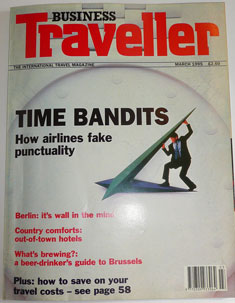Alex McWhirter looks through the Business Traveller archive. This month: a 1995 article on flight times
 Despite modern technology, it still takes longer than it used to to fly from one destination to another. In March 1995 we asked why it took 50 minutes to fly London-Paris or vice versa with British Airways in 1970, but 70-80 minutes by 1995. In 2014, you can sometimes add another five minutes to those timings.
Despite modern technology, it still takes longer than it used to to fly from one destination to another. In March 1995 we asked why it took 50 minutes to fly London-Paris or vice versa with British Airways in 1970, but 70-80 minutes by 1995. In 2014, you can sometimes add another five minutes to those timings.
The answer, as you might expect, is congestion on the ground and aloft. It means airlines inflate schedules to make their timetables more robust.
But it is ironic, as Mike Platt, Hogg Robinson Group’s then director of commercial affairs pointed out, that “with time being of the essence, we now have a situation where it takes longer to travel than before”.
Back then, a British Airways spokesperson defended the airline’s bloated timings: “The record time for London-Paris is 32 minutes in the air. Our schedules are the best estimate of what you can expect on a terminal to terminal basis. Our passengers would be very upset if we created the expectation that every flight reached Paris in 32 minutes.”
Tony Hockley, spokesperson for the now defunct consumer watchdog AUC (Air Transport Users Council), added: “We do get complaints when flights are delayed and travellers miss connections or appointments. [Extended schedules are] probably a good thing overall.”
Still, cynics argue today, as they did in 1995, that some airlines massage their punctuality figures through inflated schedules. SAS regularly claims to be the most punctual airline in Europe – hardly surprising when you learn that for a route such as Copenhagen-London (with a time aloft of 90 minutes), it allowed 120 minutes in 1995 and up to 135 minutes today. In other words, the flight is given a recovery time of 45 minutes. Similar cases prevail on SAS routes linking Oslo and Stockholm to London.
What are the drawbacks? When conditions are perfect, even short flights can arrive half an hour early. What’s wrong with that? Well, you might find that the person, taxi or hotel shuttle you were supposed to meet hasn’t yet shown up. Worse still, when you arrive 30 minutes early at Heathrow (some afternoon flights from China, Japan or South Korea can arrive 30-45 minutes early) you are kept waiting on the tarmac because no spare gate is available.
Like it or not, schedule padding is here to stay. As Platt noted: “Increasing congestion means the situation won’t get better.” And it’s the case on long-haul flights too. Virgin Atlantic’s London-New York B747 flight took seven hours 40 minutes in 1995. Today, it’s a flat eight hours.
However, the airlines know they cannot endlessly pad the schedule on two routes, namely London to Paris and Brussels. If these are over-extended, as the AUC’s Hockley pointed out, they will compare unfavourably with Eurostar.








